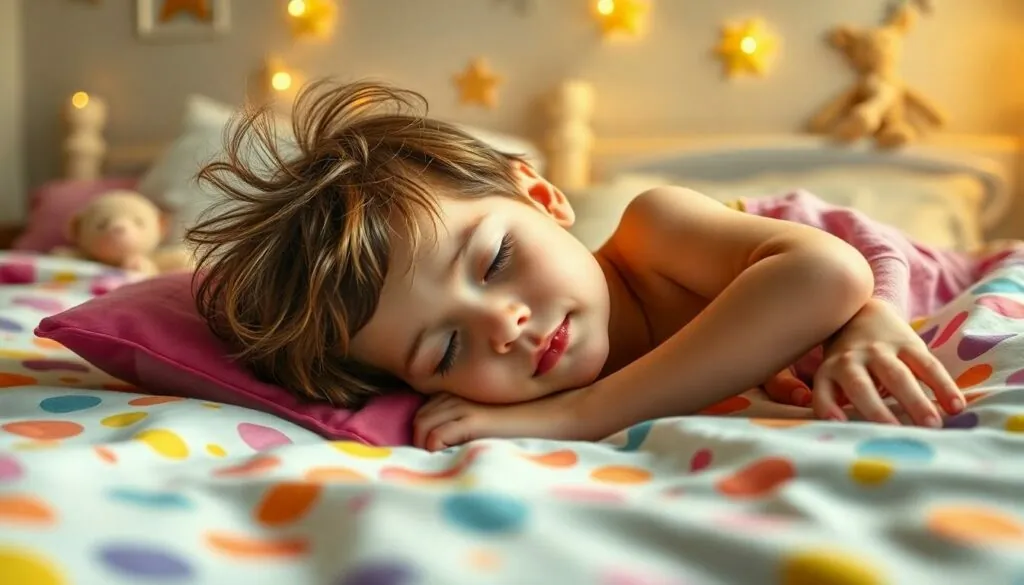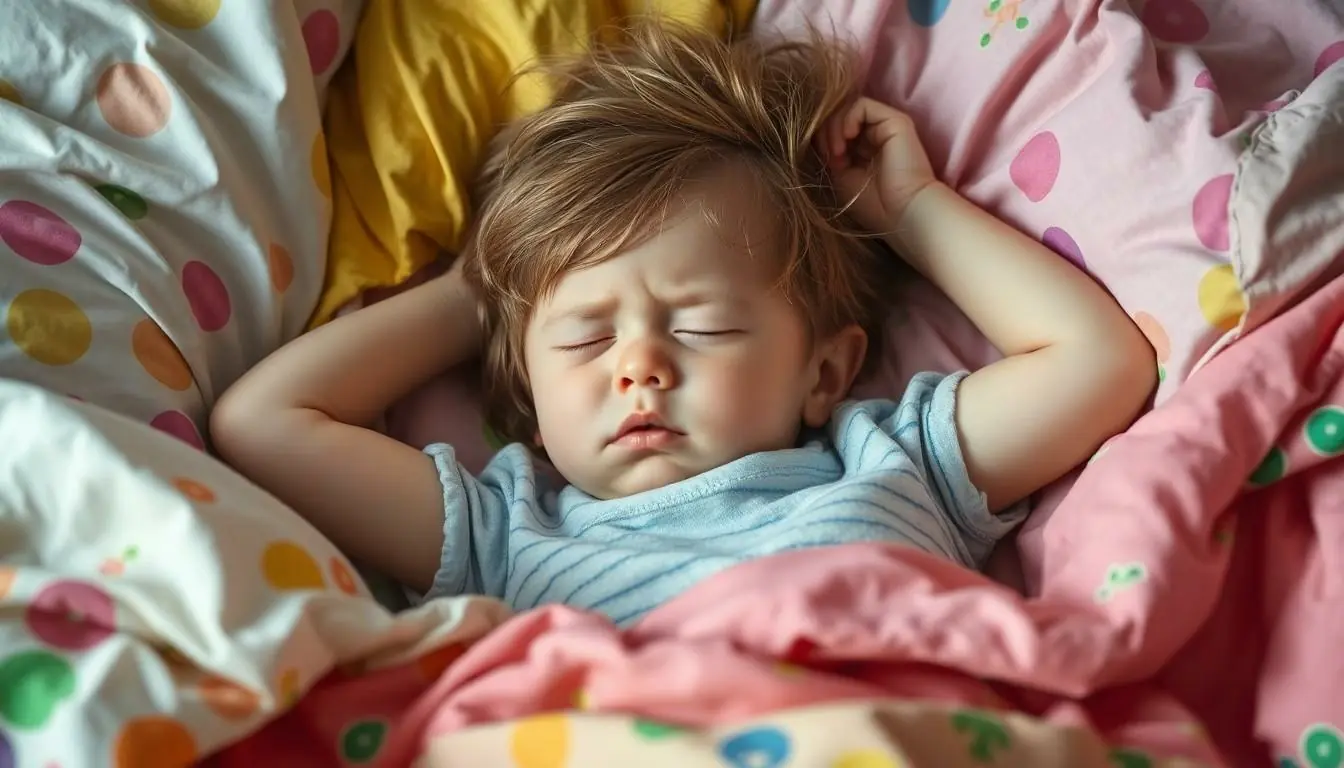Parents know the drill – tuck their little ones into bed perfectly centered and wake up to find them twisted like pretzels or completely upside down. It’s a universal experience that leaves many wondering why kids seem to practice their Olympic gymnastics routines while sleeping.
While adults might wake up in roughly the same position they fell asleep in children are natural nocturnal acrobats. This nighttime movement isn’t just random fidgeting – it’s actually a fascinating combination of developmental stages sleep cycles and natural body processes. From rapid brain development to processing daily experiences kids’ bodies are working overtime even when they’re supposedly at rest.
Table of Contents
ToggleNormal Sleep Movement Patterns in Children
Children experience distinct sleep movement patterns that differ significantly from adults. These patterns form an essential part of their growth and development during sleep.
Sleep Cycles and Movement Phases
Children move through sleep cycles every 45-60 minutes compared to adult cycles of 90-120 minutes. During these cycles, kids experience multiple transitions between non-REM and REM sleep stages. Active sleep phases trigger natural movements including:
- Twitching of arms legs during REM sleep
- Rolling over between sleep cycles
- Shifting positions during light sleep stages
- Brief awakenings with position changes
- Muscle jerks during sleep transitions
The frequency of movements peaks during specific times:
| Sleep Phase | Movement Frequency |
|---|---|
| Light Sleep | 8-12 times/hour |
| REM Sleep | 4-6 times/hour |
| Deep Sleep | 1-2 times/hour |
Age-Related Movement Changes
Movement patterns evolve as children progress through developmental stages:
- Infants (0-12 months): Experience frequent startles jerks during active sleep
- Toddlers (1-3 years): Display increased rolling repositioning behaviors
- Preschoolers (3-5 years): Show gradual reduction in movement frequency
- School-age (6-12 years): Develop more stable sleep positions
| Age Group | Average Position Changes |
|---|---|
| Toddlers | 10-15 times/night |
| Preschoolers | 8-12 times/night |
| School-age | 4-6 times/night |
Physical Factors That Increase Sleep Movement
Physical factors significantly influence children’s sleep movements, creating a pattern distinct from adult sleep behaviors. These factors emerge from both internal bodily changes and external physical activities throughout the day.
Growing Pains and Muscle Development
Growing pains manifest during sleep hours, causing children to shift positions frequently for comfort. These pain episodes typically occur in the legs, particularly the calves, thighs, and behind the knees. Children experience rapid muscle development between ages 3-12, with growth spurts triggering nighttime discomfort. The body releases growth hormone primarily during deep sleep, stimulating bone growth and muscle development. Studies show 25-40% of children experience growing pains during peak growth periods, prompting them to adjust their sleeping positions to alleviate discomfort.
Excess Energy and Physical Activity
Physical activity levels directly impact children’s sleep movement patterns. Active children who don’t expend all their energy during the day continue to move during sleep. Studies indicate children who engage in less than 60 minutes of daily physical activity show 30% more nighttime movement. The body maintains muscle memory from daytime activities, leading to increased twitching and position changes during sleep cycles. High-energy activities close to bedtime particularly influence sleep movement patterns, with children showing increased motor activity for up to 3 hours after intense physical play.
Psychological Influences on Sleep Movement
Children’s psychological state impacts their sleep patterns significantly. Emotional experiences during the day manifest in physical movements during sleep through various mechanisms.
Anxiety and Stress
Anxiety triggers increased sleep movement in children through heightened cortisol levels. Studies from the Journal of Sleep Research indicate that anxious children experience 40% more position changes during the night compared to their peers. Common stressors include:
- School-related pressure from tests grades or homework
- Social challenges with friends or siblings
- Family changes such as moves or new routines
- Separation anxiety from parents or caregivers
- Environmental factors like loud noises or darkness
Dreams and Night Terrors
Dreams and night terrors create distinct movement patterns during children’s sleep cycles. Research from the American Academy of Sleep Medicine shows that 30% of children ages 3-7 experience night terrors, causing sudden movements like:
- Sitting upright with rapid breathing
- Thrashing arms legs during REM sleep
- Running motions while lying down
- Kicking or punching during vivid dreams
- Rolling side-to-side during active dream states
These movements occur most frequently during the first three hours of sleep when dream activity peaks. Night terrors typically last 5-15 minutes producing more vigorous movements than standard dreams.
Environmental Factors Affecting Sleep Movement
A child’s sleep environment plays a crucial role in their nighttime movement patterns. External conditions directly influence both the quality of sleep and the frequency of position changes during rest periods.
Room Temperature and Comfort
The optimal bedroom temperature for children’s sleep ranges between 68-72°F (20-22°C). Temperature fluctuations outside this range trigger increased movement as children attempt to regulate their body heat. Cold rooms cause muscle tension leading to 35% more position shifts while overheated spaces prompt restlessness due to sweating. The type of bedding impacts movement patterns: lightweight breathable materials reduce nighttime shifting by 25% compared to heavy or synthetic fabrics. A firm mattress decreases unnecessary movements by providing consistent support across pressure points unlike soft surfaces that create body alignment issues requiring frequent adjustments.
Sleep Schedule and Routine
Consistent bedtimes reduce sleep movements by establishing regular circadian rhythms. Children with fixed sleep schedules experience 40% fewer position changes compared to those with irregular bedtimes. Light exposure affects movement patterns significantly – exposure to blue light from screens increases restlessness by 65% in the first 2 hours of sleep. A structured wind-down routine including activities like reading or gentle stretching reduces sleep onset movements by 30%. Environmental noise levels above 30 decibels prompt a 45% increase in sleep position changes demonstrating the importance of a quiet sleep environment.
When Sleep Movement Becomes a Concern
While some sleep movement in children is normal, excessive or unusual patterns signal potential sleep disorders that require medical attention. Understanding the difference between typical movement patterns and concerning behaviors helps parents identify when to seek professional guidance.
Signs of Sleep Disorders
Children with sleep disorders exhibit specific movement patterns beyond regular nighttime activity. Frequent leg jerking occurs more than 5 times per hour in cases of periodic limb movement disorder. Sleep apnea manifests through restless tossing accompanied by loud snoring pauses lasting over 10 seconds. Additional red flags include sleepwalking episodes lasting longer than 10 minutes, repetitive body rocking motions, or hitting objects during sleep. Physical symptoms like morning headaches muscle tension or daytime fatigue alongside these movements indicate underlying issues. Parents notice their children taking more than 30 minutes to fall asleep due to inability to stay still.
Impact on Sleep Quality
Disordered sleep movements significantly affect children’s rest cycles. Studies show children with excessive movement experience 60% less deep sleep compared to peers. These disruptions fragment sleep architecture leading to 2-3 additional awakenings per night. Daytime consequences include difficulty concentrating reduced academic performance increased irritability. Children with movement disorders spend 25% more time in light sleep stages missing crucial restorative periods. The body’s natural growth hormone production drops by 30% when sleep movement disorders remain untreated affecting physical development. Memory consolidation suffers as movement interruptions prevent the brain from properly processing daily experiences.
Conclusion
Children’s active sleep patterns are a natural and essential part of their growth and development. From physical factors like growing pains to psychological influences and environmental conditions every aspect plays a vital role in how they move during sleep.
Parents can support healthy sleep patterns by maintaining optimal room temperatures providing appropriate bedding and establishing consistent bedtime routines. While movement during sleep is typically normal watching for signs of excessive or unusual patterns helps ensure children receive the quality rest they need for proper development.
Understanding these sleep movements helps parents make informed decisions about their child’s sleep environment and know when to seek professional guidance if concerns arise.


